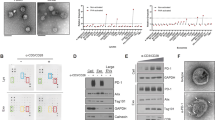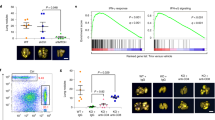Abstract
Regulatory T cells (Tregs) prevent autoimmunity and contribute to cancer progression. They exert contact-dependent inhibition of immune cells through the production of active transforming growth factor-β1 (TGF-β1). However, the absence of a specific surface marker makes inhibiting the production of active TGF-β1 to specifically deplete human Tregs but not other cell types a challenge. TGF-β1 in an inactive form binds to Tregs membrane protein Glycoprotein A Repetitions Predominant (GARP) and then activates it via an unknown mechanism. Here, we demonstrated that tumour necrosis factor receptor-associated factor 3 interacting protein 3 (TRAF3IP3) in the Treg lysosome is involved in this activation mechanism. Using a novel naphthalenelactam-platinum-based anticancer drug (NPt), we developed a new synergistic effect by suppressing ATP-binding cassette subfamily B member 9 (ABCB9) and TRAF3IP3-mediated divergent lysosomal metabolic programs in tumors and human Tregs to block the production of active GARP/TGF-β1 for remodeling the tumor microenvironment. Mechanistically, NPt is stored in Treg lysosome to inhibit TRAF3IP3-meditated GARP/TGF-β1 complex activation to specifically deplete Tregs. In addition, by promoting the expression of ABCB9 in lysosome membrane, NPt inhibits SARA/p-SMAD2/3 through CHRD-induced TGF-β1 signaling pathway. In addition to expose a previously undefined divergent lysosomal metabolic program-meditated GARP/TGF-β1 complex blockade by exploring the inherent metabolic plasticity, NPt may serve as a therapeutic tool to boost unrecognized Treg-based immune responses to infection or cancer via a mechanism distinct from traditional platinum drugs and currently available immune-modulatory antibodies.

This is a preview of subscription content, access via your institution
Access options
Subscribe to this journal
Receive 50 print issues and online access
$259.00 per year
only $5.18 per issue
Buy this article
- Purchase on Springer Link
- Instant access to full article PDF
Prices may be subject to local taxes which are calculated during checkout





Similar content being viewed by others
References
Cuende J, Liénart S, Dedobbeleer O, van der Woning B, De Boeck G, Stockis J, et al. Monoclonal antibodies against GARP/TGF-β1 complexes inhibit the immunosuppressive activity of human regulatory T cells in vivo. Sci Transl Med. 2015;7:28456.
Sakaguchi S, Miyara M, Costantino CM, Hafler DA. FOXP3+ regulatory T cells in the human immune system Nat. Rev. Immunol. 2010;10:490–500.
Jacobs JFM, Nierkens S, Figdor CG, de Vries IJM, Adema GJ. Regulatory T cells in melanoma: the final hurdle towards effective immunotherapy? Lancet Oncol. 2012;13:e32–42.
Moreau JM, Velegraki M, Bolyard C, Rosenblum MD, Li Z. Transforming growth factor-β1 in regulatory T cell biology. Sci Immunol. 2022;7:eabi4613.
Salem M, Wallace C, Velegraki M, Li A, Ansa-Addo E, Metelli A, et al. Cancer Res. 2019;79:1178–90.
Yan Y, Huang L, Liu Y, Yi M, Chu Q, Jiao D, et al. J Hematol Oncol. 2022;15:104.
De Candia P, Procaccini C, Russo C, Lepore MT, Matarese G, Regulatory T. cells as metabolic sensors. Immunity. 2022;55:1981–92.
Yu X, Teng XL, Wang F, Zheng Y, Qu G, Zhou Y, et al. Metabolic control of regulatory T cell stability and function by TRAF3IP3 at the lysosome. J Exp Med. 2018;215:2463–76.
Travis MA, Sheppard D. TGF-β activation and function in immunity. Annu Rev Immunol. 2014;32:51–82.
Derynck R, Turley SJ, Akhurst RJ. TGFβ biology in cancer progression and immunotherapy. Nat Rev Clin Oncol. 2021;18:9–34.
Wang C, Wang C, Wei Z, Li Y, Wang W, Li X, et al. Suppression of motor protein KIF3C expression inhibits tumor growth and metastasis in breast cancer by inhibiting TGF-β signaling. Cancer Lett. 2015;368:105–14.
Tang X, Shi L, Xie N, Liu Z, Qian M, Meng F, et al. SIRT7 antagonizes TGF-β signaling and inhibits breast cancer metastasis. Nat Commun. 2017;8:318.
Bai X, Ni J, Beretov J, Graham P, Li Y. Triple-negative breast cancer therapeutic resistance: Where is the Achilles’ heel? Cancer Lett. 2021;497:100–11.
Bianchini G, Balko JM, Mayer IA, Sanders ME, Gianni L. Triple-negative breast cancer: challenges and opportunities of a heterogeneous disease. Nat Rev Clin Oncol. 2016;13:674–90.
Rottenberg S, Disler C, Perego P. The rediscovery of platinum-based cancer therapy. Nat Rev Cancer. 2021;21:37–50.
Oshimori N, Oristian D, Fuchs E. TGF-β promotes heterogeneity and drug resistance in squamous cell carcinoma. Cell. 2015;160:963–76.
Li S, Song Y, Quach C, Guo H, Jang GB, Maazi H, et al. Transcriptional regulation of autophagy-lysosomal function in BRAF-driven melanoma progression and chemoresistance. Nat Commun. 2019;10:1693.
Niu J, Li W, Liang C, Wang X, Yao X, Yang RH, et al. EGF promotes DKK1 transcription in hepatocellular carcinoma by enhancing the phosphorylation and acetylation of histone H3. Sci Signal. 2020;13:eabb5727.
Ge C, Wang Y, Feng Y, Wang S, Zhang K, Xu X, et al. Suppression of oxidative phosphorylation and IDH2 sensitizes colorectal cancer to a naphthalimide derivative and mitoxantrone. Cancer Lett. 2021;519:30–45.
Ma J, Wang Q, Huang Z, Yang X, Nie Q, Hao W, et al. Glycosylated platinum(IV) complexes as substrates for glucose transporters (GLUTs) and organic cation transporters (OCTs) exhibited cancer targeting and human serum albumin binding properties for drug delivery. Med Chem. 2017;60:5736–48.
Liu H, Ma J, Li Y, Yue K, Li L, Xi Z, et al. Polyamine-based Pt(IV) prodrugs as substrates for polyamine transporters preferentially accumulate in cancer metastases as DNA and polyamine metabolism dual-targeted antimetastatic agents. J Med Chem. 2019;62:11324–34.
Ma J, Li L, Yue K, Zhang Z, Su S, Chen Y, et al. A naphthalimide-polyamine conjugate preferentially accumulates in hepatic carcinoma metastases as a lysosome-targeted antimetastatic agent. Eur J Med Chem. 2021;221:113469.
Ma J, Yang X, Hao W, Huang Z, Wang X, Wang PG. Mono-functionalized glycosylated platinum(IV) complexes possessed both pH and redox dual-responsive properties: exhibited enhanced safety and preferentially accumulated in cancer cells in vitro and in vivo. Eur J Med Chem. 2017;128:45–55.
Jin S, Muhammad N, Sun Y, Tan Y, Yuan H, Song D, et al. Multispecific platinum(IV) complex deters breast cancer via interposing inflammation and immunosuppression as an inhibitor of COX-2 and PD-L1. Angew Chem Int Ed. 2020;59:23313–21.
Jiang F, Hu Q, Zhang Z, Li H, Li H, Zhang D, et al. Discovery of benzo[cd]indol-2(1 H)-ones and pyrrolo[4,3,2- de]quinolin-2(1 H)-ones as bromodomain and extra-terminal domain (BET) inhibitors with selectivity for the first bromodomain with potential high efficiency against acute gouty arthritis. J Med Chem. 2019;62:11080–107.
Liu Z, Wang P, Chen H, Wold EA, Tian B, Brasier AR, et al. Discovery of benzo[cd]indol-2(1 H)-ones and pyrrolo[4,3,2- de]quinolin-2(1 H)-ones as bromodomain and extra-terminal domain (BET) inhibitors with selectivity for the first bromodomain with potential high efficiency against acute gouty arthritis. J Med Chem. 2017;60:4533–58.
Andrieu G, Tran AH, Strissel KJ, Denis GV. BRD4 regulates breast cancer dissemination through Jagged1/Notch1 signaling. Cancer Res. 2016;76:6555–67.
Li J, Tian R, Ge C, Chen Y, Liu X, Wang Y, et al. Discovery of the polyamine conjugate with benzo[cd]indol-2(1 H)-one as a lysosome-targeted antimetastatic agent. J Med Chem. 2018;61:6814–29.
Sonnenschein C, Soto AM. Cancer metastases: so close and so far. Cancer Inst. 2015;107:djv236.
Galluzzi L, Buqué A, Kepp O, Zitvogel L, Kroemer G. Immunogenic cell death in cancer and infectious disease. Nat Rev Immunol. 2017;17:97–111.
Pawelec G, Verschoor CP, Ostrand-Rosenberg S. Myeloid-derived suppressor cells: not only in tumor immunity. Front Immunol. 2019;10:1099.
Cheng K, Hao M. Metformin inhibits TGF-β1-induced epithelial-to-mesenchymal transition via PKM2 relative-mTOR/p70s6k signaling pathway in cervical carcinoma cells. Int J Mol Sci. 2016;17:2000.
Szakacs G, Abele R. An inventory of lysosomal ABC transporters. FEBS Lett. 2020;594:3965–85.
Dong Z, Zhong Z, Yang L, Wang S, Gong Z. MicroRNA-31 inhibits cisplatin-induced apoptosis in non-small cell lung cancer cells by regulating the drug transporter ABCB9. Cancer Lett. 2014;343:249–57.
Hou L, Zhang X, Jiao Y, Li Y, Zhao Y, Guan Y, et al. ATP binding cassette subfamily B member 9 (ABCB9) is a prognostic indicator of overall survival in ovarian cancer. Medicine. 2019;98:e15698.
Xie F, Zhou X, Su P, Li H, Tu Y, Du J, et al. Breast cancer cell-derived extracellular vesicles promote CD8+ T cell exhaustion via TGF-β type II receptor signaling. Nat Commun. 2022;13:4461.
Li S, Liu M, Do MH, Chou C, Stamatiades EG, Nixon BG, et al. Cancer immunotherapy via targeted TGF-β signalling blockade in TH cells. Nature. 2020;587:121–5.
Liu YY, Liu HY, Yu TJ, Lu Q, Zhang FL, Liu GY, et al. O-GlcNAcylation of MORC2 at threonine 556 by OGT couples TGF-β signaling to breast cancer progression. Cell Death Differ. 2022;29:861–73.
Troilo H, Barrett AL, Wohl AP, Jowitt TA, Collins RF, Bayley CP, et al. The role of chordin fragments generated by partial tolloid cleavage in regulating BMP activity. Biochem Soc Trans. 2015;43:795–800.
Munn DH, Bronte V. Immune suppressive mechanisms in the tumor microenvironment. Curr. Opin. Immunol. 2016;39:1–6.
Lainé A, Labiad O, Hernandez-Vargas H, This S, Sanlaville A, Léon S, et al. Regulatory T cells promote cancer immune-escape through integrin αvβ8-mediated TGF-β activation. Nat Commun. 2021;12:6228.
Whiteside TL. FOXP3+ Treg as a therapeutic target for promoting anti-tumor immunity. Expert Opin Ther Targets. 2018;22:353–63.
Goenka A, Khan F, Verma B, Sinha P, Dmello CC, Jogalekar MP, et al. TGF-β signaling in the tumor metabolic microenvironment and targeted therapies. J Hematol Oncol. 2022;15:135.
Kun P, Bing-Bing L, Wenting L, Zong-Wan M. What blocks more anticancer platinum complexes from experiment to clinic: major problems and potential strategies from drug design perspectives. Coord Chem Rev. 2021;449:214210.
Acknowledgements
This work was supported by the second batch of provincial science and technology research and development plan joint funds (225200810116), the 16th batch of special grant (station) from China Postdoctoral Foundation (2023T160190), the China Postdoctoral Science Foundation (Grant 2021M701089), Key Scientific Research Projects in Henan Colleges and Universities (Grant No. 22A350002), Natural Science Foundation of Henan Province (232300420047), the key scientific research projects of universities in Henan province (222102310402 and 222102310216), Key Program “New Drug Creation” of Guangdong Key Research, Development Plan (No.2019B020202001), and the Youth Promotion Project of Zhongzhou Laboratory for Integrative Biology.
Author information
Authors and Affiliations
Contributions
The study was instructed by all authors. CYT and TL collected the primary literature and performed the major work and drafted the manuscript. CY and HB prepared the figures. CY made critical revisions and commentary on this manuscript and coordinated with all the authors. ZYR, LXY, LYR, and YKX made proper and necessary investigations and validation of this work. ZZZ and ZW provided partly the structures of mentioned chemicals. BGC, WP, WCJ, XSQ, and MJ directed and guided the whole work. MJ obtained the funding. All authors read and approved the final manuscript.
Corresponding authors
Ethics declarations
Competing interests
The authors declare no competing interests.
Additional information
Publisher’s note Springer Nature remains neutral with regard to jurisdictional claims in published maps and institutional affiliations.
Supplementary information
Rights and permissions
Springer Nature or its licensor (e.g. a society or other partner) holds exclusive rights to this article under a publishing agreement with the author(s) or other rightsholder(s); author self-archiving of the accepted manuscript version of this article is solely governed by the terms of such publishing agreement and applicable law.
About this article
Cite this article
Ma, J., Chen, Y., Li, T. et al. Suppression of lysosome metabolism-meditated GARP/TGF-β1 complexes specifically depletes regulatory T cells to inhibit breast cancer metastasis. Oncogene (2024). https://doi.org/10.1038/s41388-024-03043-y
Received:
Revised:
Accepted:
Published:
DOI: https://doi.org/10.1038/s41388-024-03043-y



